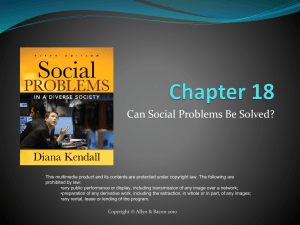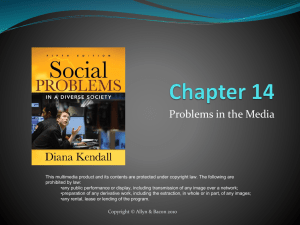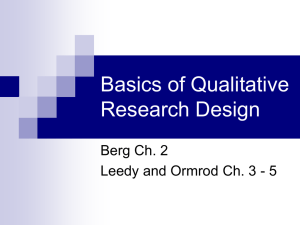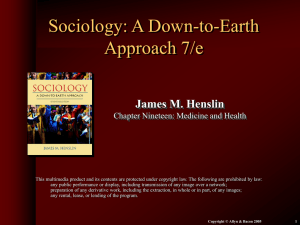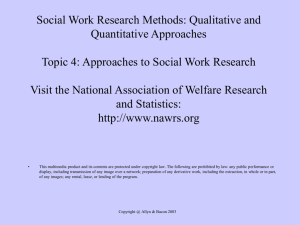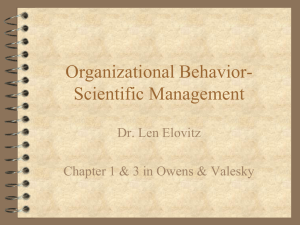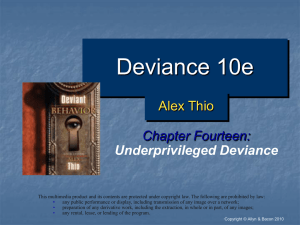Chapter 3
advertisement
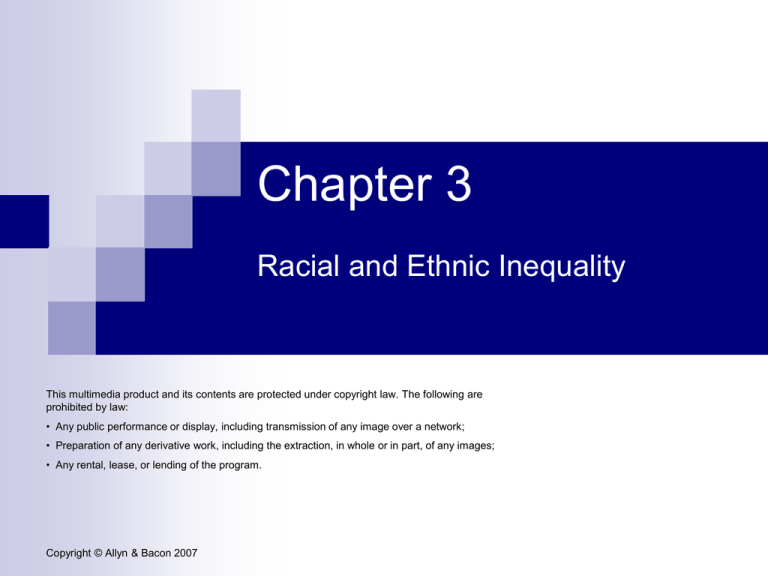
Chapter 3 Racial and Ethnic Inequality This multimedia product and its contents are protected under copyright law. The following are prohibited by law: • Any public performance or display, including transmission of any image over a network; • Preparation of any derivative work, including the extraction, in whole or in part, of any images; • Any rental, lease, or lending of the program. Copyright © Allyn & Bacon 2007 Sociological Definition of a Racial Group Group defined as inferior or superior Based on subjective physical characteristics (e.g., skin color, hair texture, eye shape) African American, Native American, Asian American Figure 3.3: Percent of the U.S. Population by Race and Hispanic Origin: 2003, 2025, and 2050 (middle-series projections) Source: U.S. Census Burrau, 2004a, 2004c. Copyright © Allyn & Bacon 2007 Figure 3.2: Race and Hispanic Origin Source: U.S. Census Bureau, 2004a. Copyright © Allyn & Bacon 2007 Dominant and Subordinate Groups Dominant or majority group Is advantaged Has superior rights and resources Is based on race or ethnicity Is also based on gender, sexual orientation, physical ability Copyright © Allyn & Bacon 2007 Subordinate or minority group Is disadvantaged Is subject to unequal treatment Is based on physical or cultural characteristics See themselves as objects of discrimination Figure 3.1: Median U.S. Family Income, by Type of Family and Race of Householder, 2003 Source: U.S. Census Bureau, 2004b. Copyright © Allyn & Bacon 2007 Racism Set of attitudes, beliefs, or practices Justifies the superior or inferior treatment of racial and ethnic groups White racism denies rights and privileges to people of color Copyright © Allyn & Bacon 2007 Prejudice Negative attitudes about people Based on racial or ethnic characteristics Rooted in ethnocentrism Results in stereotypes Copyright © Allyn & Bacon 2007 Discrimination Practices of dominant group that harm subordinate groups: Individual discrimination is one-on-one acts. Taxi driver who refuses to pick up African American passengers Institutional discrimination is day-to-day practices of organizations and institutions. Copyright © Allyn & Bacon 2007 Social-Psychological Explanations Frustration-aggression hypothesis Frustration in achieving goal leads to aggression towards others Scapegoats Blaming others (illegal aliens) for someone else’s failure Authoritarian personality Type of personality where one is intolerant, insecure, rigid, submissive to authority and thinks primarily in stereotypes Copyright © Allyn & Bacon 2007 Symbolic Interactionist Perspectives Racial socialization Is learned from parents, caregivers, and media representations Contains specifics concerning Personal and group identity Intergroup and individual relationships One’s position in social stratification Copyright © Allyn & Bacon 2007 Functionalist Perspectives Racial/ethnic discord and urban unrest are dysfunctional for society Processes for addressing racial problems include: Assimilation: absorbed into dominant culture Amalgamation: groups “melt” together to form new society Ethnic pluralism: coexistence of diverse groups with separate identities Segregation: separation of groups Copyright © Allyn & Bacon 2007 Conflict Perspectives Role of capitalist class in racial exploitation Split-labor Primary and Secondary sector Racial inequality and gender oppression Capitalist market theory exploitation of minority women Internal colonialism Minorities forcibly placed under economic and political control remain in subordinate positions much longer than other groups Theory of racial formation Government’s Copyright © Allyn & Bacon 2007 legislation and laws impact minorities Inequality Among Racial & Ethnic Groups Native Americans 15 million lived in US 1492 White Europeans engaged in genocide Deliberate killing of people Indian Removal Act of 1830 Forced to move to accommodate white settlers “Trail of Tears” Children Copyright © Allyn & Bacon 2007 were forced to Americanize African Americans and Inequality Contemporary stereotypical media images “Welfare mother” and “menacing black male criminals” Forced into slavery to enrich US economics After slavery De De jure segregation: laws that enforced separation Jim Crow Laws facto segregation: separation by norms Still exists today Copyright © Allyn & Bacon 2007 Hispanic Americans and Inequality Contemporary stereotypical media images “Drug lords” and “illegal aliens” Internal colonization Mexican-American War Anglo-Americans took possession of their land Exclusionary immigration Allowed to migrate when the US needed agricultural workers Detained or deported during economic depression Copyright © Allyn & Bacon 2007 Asian and Pacific Americans and Inequality Contemporary stereotypical media images “Exotic beauties” or “model minority” Exclusionary immigration Chinese Exclusion Act of 1882 Chinese laborers seen as a threat to Americans Act halted Chinese immigration to US Internment camps Japanese Americans Copyright © Allyn & Bacon 2007 forced into camps during WWII Common Experiences of Subordinate Groups Been the object of stereotyping and discrimination Resisted oppression and strived for a better life Been the object of governmental policies to shape its place (or lack thereof) Copyright © Allyn & Bacon 2007 Reducing Racial and Ethnic Inequalities Functionalist Perspective: Restructuring social institutions Conflict Perspective: Struggle and political action Interactionist Perspective: Unlearning prejudice and discrimination through social interaction Copyright © Allyn & Bacon 2007



